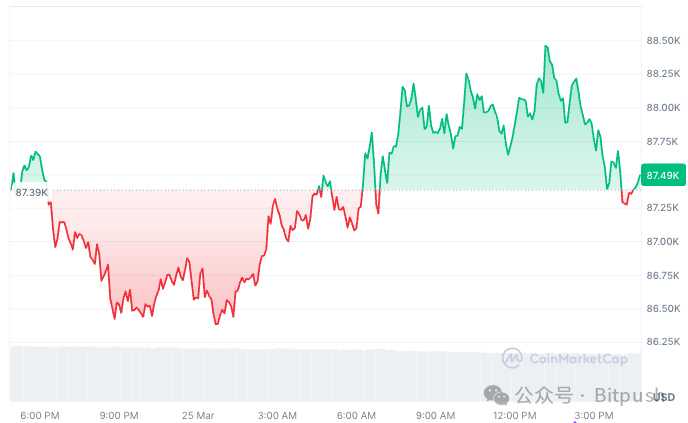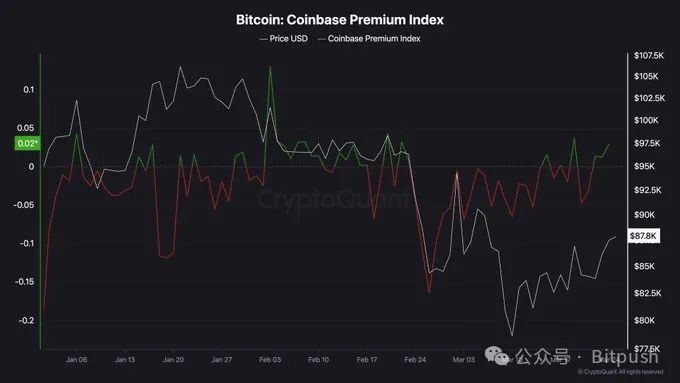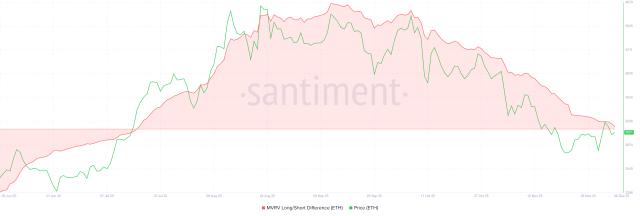Written by: BitpushNews
Over the past 24 hours, the cryptocurrency market showed a moderate rebound, with Bitcoin price fluctuating narrowly around $87,400, and Ethereum slightly retreating to $2,070. Among mainstream cryptocurrencies, Solana (SOL) rose against the trend by 2%, reaching a daily high of $146.
As of March 26 Beijing time, the total crypto market value slightly increased by 0.4% to $2.87 trillion, with the Fear & Greed Index dropping to 34, indicating investors remain cautious.

In news, the former "Wall Street meme" stock, GameStop, officially announced on the 25th that its board unanimously approved incorporating Bitcoin into its balance sheet reserves. GameStop surged 7% in after-hours trading, with its stock price rising to $27.19.
This decision had been hinted at earlier: two months ago, after a photo of GameStop CEO Ryan Cohen meeting with BTC bull Michael Saylor surfaced, its major shareholder Strive Asset Management publicly called for the company to emulate MicroStrategy's bitcoin holding strategy. Strive's CEO Matt Cole stated: "We believe GameStop can improve its financial position by purchasing Bitcoin, which is a strategic allocation".
Is BTC Breaking Out of Adjustment?
On-chain data reveals new trends in capital flow. CryptoQuant data shows that despite Bitcoin's stable price trend, on-chain data reveals key signals:
Institutional fund migration: In the past 24 hours, 17 BTC transfers exceeded $100 million, with total on-chain transfer volume surging 268%, reaching a three-month high.
Exchange flow: Coinbase showed a maximum positive premium of 0.3%, while BTC exchange reserves decreased by 1%, with about 12,000 bitcoins flowing into cold wallets. This "low volatility, high circulation" trend suggests institutional investors may be conducting large-scale asset custody transfers.

Derivatives market balance: Perpetual contract funding rates returned to the neutral 0.01% range, with the options volatility surface showing a put/call ratio (PCR) dropping to 0.85, indicating a slight increase in bullish sentiment.
Notably, Bitcoin's Net Unrealized Profit/Loss (NUPL) has fallen from 0.68 last week to 0.55, indicating some short-term holders are taking profits. Glassnode data shows that the number of addresses holding over 1,000 BTC increased by 12 against the trend, suggesting whale accounts are quietly accumulating.
Hani Abuagla, senior analyst at XTB MENA, believes Bitcoin is emerging from the second deepest adjustment in this cycle, and if the Federal Reserve's rate cut expectations and trade policy easing converge, the possibility of breaking through $100,000 in spring still exists.
Macro Variable: PCE Data Becomes Crucial Touchstone
The US February core PCE price index to be released this Friday (March 28) may become a key variable breaking market balance. As the Federal Reserve's most closely watched inflation indicator, the market expects the core PCE year-on-year growth rate to slightly increase from 1.8% in January to 2.7%. If the data exceeds expectations, it may further delay market expectations for rate cuts.
Currently, the CME FedWatch tool shows that traders' expectations for the Federal Reserve's rate cuts this year have narrowed to 50-75 basis points, with the first rate cut possibly delayed to the third quarter. If the PCE data reinforces the "inflation stickiness" narrative, US bond yields may rise again, and a strong US dollar could short-term suppress risk assets. In the current market context, subtle inflation data fluctuations may indirectly affect the cryptocurrency market's direction by changing liquidity expectations.
TradingView analysts suggest that for short-term traders, they can focus on the breakthrough direction of Bitcoin's $87,000 support and $90,000 resistance levels, and construct volatility strategies with options at low IV. For medium to long-term holders, the on-chain MVRV ratio (1.98) remains below the historical bull market peak (3.5), and the address dispersion indicator shows a healthy chip structure, making staged buying during pullbacks a viable option.






